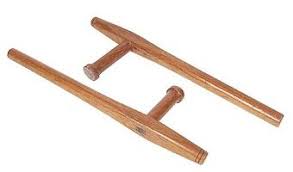The Tonfa, being a preferred weapon in Karate, aligns seamlessly with stance and upper body techniques. Ippon pairs work, structured similarly to the empty-hand format, further reinforces the integration of Tonfa techniques into established Karate principles.

The tonfa, measuring about three centimetres past the elbow when gripped, is a versatile weapon with three primary grips: honte-mochi (natural), gyakute-mochi (reverse), and tokushu-mochi (special). The natural grip aligns the handle with the long arm along the bottom of the forearm, providing protection and reinforcement for strikes like back fists, elbow strikes, and punches. The tonfa can be swung out to the gyakute grip for strikes or thrusts. Martial artists can also use the tokushu-mochi grip, flipping the tonfa and grabbing it by the shaft, allowing the handle to function as a hook in combat. Many tonfa forms reflect empty hand techniques, showcasing their adaptability.
Originally from China and Southeast Asia, the Sai, commonly associated with Okinawan martial arts, has ancient versions found in China and forms/Kata present in Chinese arts like Kung Fu.
Tonfa are typically used in pairs, serving as an augmentation for blocks and strikes in Karate and other martial arts. Gripped with the main section across the underside of the forearm, the short protruding end delivers strikes to vulnerable areas such as the solar plexus, throat, ribs, and armpits. The tonfa’s handle can be swung in a directed arc for attacks, or held at the bottom for a basic club-like use. The side handle can also be utilized as a hook to catch and trap weapons, akin to kama techniques. Due to its defensive capabilities, tonfa-like batons have been adapted as the primary non-firearm weapon for various police and special force units. The tonfa’s versatility makes it a starting with Uke Waza and Uke Tsuki waza provides students with a familiar foundation from empty-hand forms, allowing them to develop a tactile sense of the weapon. This approach leverages their existing understanding of body mechanics and structure, making it an ideal introduction to the Tonfa. The Tonfa-like batons have been adapted as the main non-firearm weapon for various police and special force units.
The System
Uke Waza
Uke Tsuki Waza
Mataoshi Tonfa Dai Ichi
Ippon Kumite Tonfa Vs Bo
The student will start with Uke Waza and Uke Tsuki waza as these are familiar forms from the empty hand enabling the students to get a feel of the weapon as they already have a good foundation to the body mechanics and structure and is a prefect introduction to the Tonfa
The Tonfa is a karate weapon of choice as stance and upper body techniques are exactly the same as is the Ippon pairs work which is structured as the empty hand format.
Sensei Pete Halloran, our esteemed Okinawan weapons instructor, not only imparts his knowledge of Tonfa but also holds a crucial role on the Shizendo Technical Committee. In this capacity, he contributes to maintaining and upholding standards within our organization, ensuring a high level of proficiency and authenticity in the teachings of Okinawan weapons techniques.